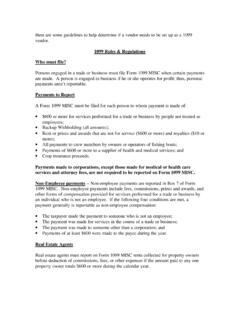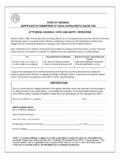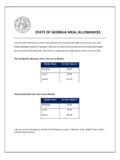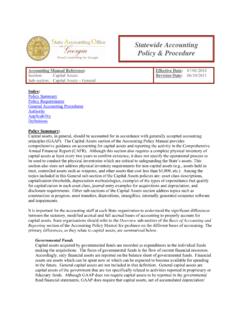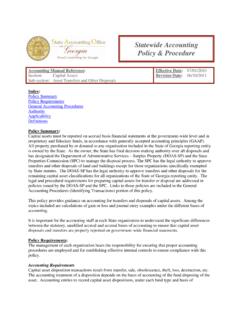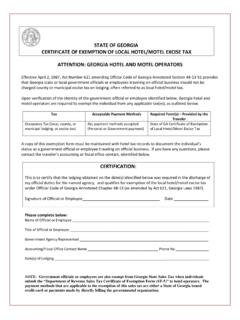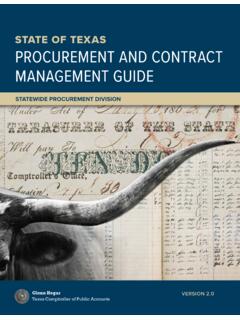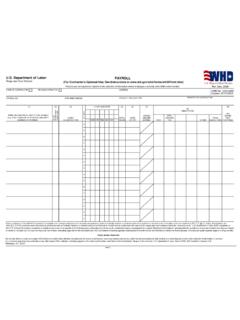Transcription of Components of an Effective Contract Monitoring System
1 Russell W. Hinton State Auditor Department of Audits and Accounts Performance Audit Operations Division 254 Washington Street, SW Suite 214 Atlanta, GA 30334 BEST PRACTICES IN GOVERNMENT Components of an Effective Contract Monitoring System July 2003 Components of an Effective Contract Monitoring System Table of Contents Executive Purpose of 1 Overview of Service Contracts ..1 Georgia s Contracting System ..2 Overview of Contract 4 Causes and Impact of Inadequate Monitoring .. 5 Contract Monitoring in Other States .. 7 Report Scope and 8 Components of an Effective Contract Monitoring 10 Training in Contract Monitoring .. 10 Written Policies and Procedures .. 12 Contingency 13 Communicating Clear Expectations to Vendors .. 14 Contract Administration 17 Organized Contract 18 Payments Linked to Satisfactory Performance .. 19 Regular Programmatic Reports from Vendor .. 20 On-Site Monitoring .. 21 Use of Incentives and Consequences for Poor Performance.
2 22 Access to Records/Right to Audit 24 Measuring Customer Satisfaction .. 24 Dispute Resolution Procedures .. 25 Closeout 27 Post- Contract Review .. 27 Appendix A .. 29 Appendix B .. 31 Appendix C .. 32 i PPuurrppoossee ooff RReeppoorrtt The purpose of this report is to increase awareness of the importance of Contract Monitoring and to explain the basic tools used in Monitoring . It provides agency management with an overview of the methods their agency should be using and serves as a resource for individuals who are directly responsible for ensuring that contracted services are adequately delivered. The full report provides a description of each of the Components of an Effective Contract Monitoring System and gives a brief overview of other states and Georgia state agencies current use of those Components .
3 A state agency s Contract Monitoring System is the structure, policies, and procedures used to ensure that the objectives of a Contract are accomplished and vendors meet their responsibilities. An Effective Contract Monitoring System mitigates risk, with risk defined as the probability of an event or action having an adverse effect on a state agency . This report is also intended as a guide for state agencies to use in reviewing their current Contract Monitoring System to ensure their current System is operating as intended and that the System is sufficiently mitigating risk. It should be noted that state agencies distributing grant funds have an obligation to ensure that recipients adequately perform all agreed-upon services. The Components of an Effective Contract Monitoring System may also be used to monitor services performed by grant recipients. OOvveerrvviieeww ooff SSeerrvviiccee CCoonnttrraaccttss State agencies Contract out services for a variety of reasons, including: RRuusssseellll HHiinnttoonn,, SSttaattee AAuuddiittoorr EXECUTIVE SUMMARY Best Practices in Government Components of an Effective Contract Monitoring System July 2003 Performance Audit Operations Division 254 Washington St.
4 Of Audits and Accounts Atlanta, GA 30334-8400 Several terms related to contracting are often used interchangeably, despite the fact that they have slightly different definitions. The General Accounting Office (GAO) uses the following terms. Privatization Any process aimed at shifting functions and responsibilities, in whole or in part, from the government to the private sector. Outsourcing One method of privatization. The government entity remains fully responsible for the provision of affected services and maintains control over management decisions, while another entity operates the function or performs the service. It may include contracting out, the granting of franchises, and the use of volunteers to deliver public services. Contracting Out One type of outsourcing. The hiring of private-sector firms or nonprofit organizations to provide goods or services for the government. Under this approach, the government remains the financier and has management and policy control over the type and quality of services to be provided.
5 Thus the government can replace contractors that do not perform well. Source: General Accounting Office Contracting Terms ii Reducing costs; Improving service quality; Insufficient in-house staff; Insufficient expertise; The demand for the service may fluctuate ( , tax return processing), making the flexibility provided by the use of vendors preferable for the agency ; and The General Assembly may appropriate funds to a state agency for the purpose of contracting out services to a specific vendor. While there is no comprehensive listing of all state agency contracts, in January 2001, the Department of Audits and Accounts issued a report that inventoried three common Contract types: consulting, outsourcing, and any interagency contracts that did not fall into the two prior categories. Seventy-seven of 87 agencies responding to the survey reported 5,895 eligible contracts totaling more than $ billion in fiscal year 2000.
6 The Department of Human Resources reported the largest number of contracts and the highest total value of any agency 1,847 contracts valued at approximately $649 million. The Department of Corrections reported the largest Contract at more than $85 million for prisoner health services. While numerous state entities reported few and/or small contracts, such as the Sheriffs Retirement Fund s one Contract for $9,750 or the Subsequent Injury Trust Fund s two contracts for $2,909, all entities that Contract out services should have an appropriate System to monitor their contracts. GGeeoorrggiiaa ss CCoonnttrraaccttiinngg SSyysstteemm The Department of Administrative Services (DOAS) and the state agencies contracting out services each play significant roles in Georgia s contracting System . Depending on the state agency , the amount of the procurement, and the service being procured, DOAS may assist the agency in soliciting bids, selecting a vendor, and negotiating the Contract .
7 If a procurement is exempt from DOAS involvement due to statutes or policy, the purchasing state agency handles all aspects of the procurement, including the solicitation of bids (if any) and the negotiation of Contract provisions and Contract amount. Once Contract services begin, state agencies become primarily responsible for ensuring that the vendor is meeting Contract obligations, paying the vendor, and performing any other necessary activities. OOvveerrvviieeww ooff CCoonnttrraacctt MMoonniittoorriinngg Contract Monitoring is a process of ensuring that a vendor adequately performs a contracted service. The level and type of Monitoring conducted by state agencies is primarily at their discretion. State law does not address Contract Monitoring . While DOAS offers guidelines for Monitoring contracts, it imposes only minimal Contract Monitoring requirements on agencies. CCaauusseess aanndd IImmppaacctt ooff IInnaaddeeqquuaattee MMoonniittoorriinngg Deficiencies in Contract Monitoring are related to violations of good management principles.
8 Inadequate Monitoring is often the result of the following: Poorly established criteria for evaluating vendor performance; Perception of oversight as a responsibility to develop a partnership rather than enforce rules, regulations, or Contract provisions; Focus on rules and regulations rather than outcomes; iii Failure to conduct follow-up reviews to ensure that corrective action was taken; and, Failure to identify the risk and level of review necessary for each vendor. Good management and supervision requires follow-up, feedback, and enough awareness of what is occurring to eliminate surprises. When conducting performance audits and program evaluations, the Department of Audits and Accounts often observes problems with Contract Monitoring . CCoommppoonneennttss ooff aann EEffffeeccttiivvee CCoonnttrraacctt MMoonniittoorriinngg SSyysstteemm State agencies can mitigate the risks associated with contracting out services by developing an Effective Contract Monitoring System .
9 The Components of an Effective Contract Monitoring System are detailed below. State agencies should assess the complexity of the contracted service, the Contract amount, and the risk if the work is not performed adequately when deciding what Components are necessary. TTrraaiinniinngg iinn CCoonnttrraacctt MMoonniittoorriinngg Training in Contract Monitoring increases the likelihood that individuals will monitor contracts reliably by giving them the appropriate background knowledge related to contracts. Many of the topics that should be included in Contract Monitoring training are included in the list of Components of an Effective Contract Monitoring System . WWrriitttteenn PPoolliicciieess aanndd PPrroocceedduurreess Written policies and procedures serve as a guide to agencies and their personnel in ensuring a consistent, high-quality Contract Monitoring process. CCoonnttiinnggeennccyy PPllaannss Agencies without contingency plans risk interruption of services when vendors default on their obligations and may pay additional costs for taking back services.
10 A number of options are available for a default contingency plan: contracting with the next lowest bidder from the original solicitation; using another current vendor; delivering the service in-house; and contracting with another government entity. CCoommmmuunniiccaattiinngg CClleeaarr EExxppeeccttaattiioonnss ttoo VVeennddoorrss Creating a detailed Statement of Work, having performance measures in the Contract , and holding a post-award meeting with the vendor contribute to the vendor s understanding of what is required under the Contract . By clearly stating Contract requirements and performance goals, the agency reduces the potential for poor performance. A post-award meeting allows staff that may not have been involved with the procurement process to answer questions that the vendor might have and clarify technical aspects of the Contract . CCoonnttrraacctt AAddmmiinniissttrraattiioonn PPllaann A Contract administration plan is a cursory view of planned and completed activities and can be utilized throughout the Contract period as a status report.
